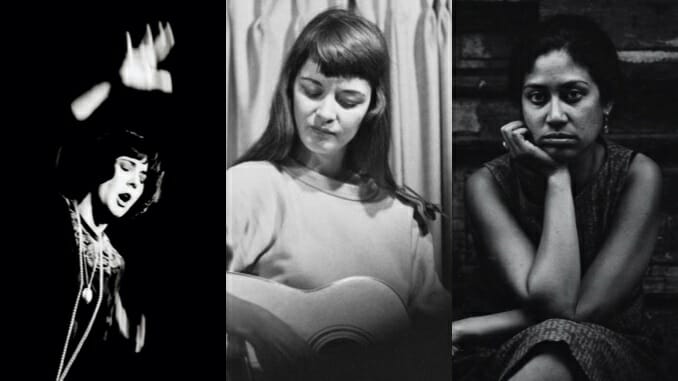Karen Dalton and The Overlooked Heroines of ’60s Folk
Photos by Lars Spayer, Kai Mort Shuman/courtesy of Mark Linn and Jan McLain, Ralph Weiss
The highway of pop-music history took a detour on the backroads during the folk music boom of the 1960s. For a brief period, musicians could be celebrated not for making a big noise, but for crafting a small sound; not for finding something new, but for rediscovering something old; not for describing universal experiences, but for sharing exceedingly personal encounters.
Of course, there was acoustic folk music before that decade—and has been ever since. What was different, for a while there, was a large enough audience that a singer with an acoustic guitar and a personal story had the financial incentive, the financial security, to not only get better, but to also become distinctive. For a moment, it was hip to play old styles from the Appalachian Mountains and Mississippi Delta in stripped-down arrangements.
Out of that scene emerged some of America’s finest songwriters: Bob Dylan, Joni Mitchell, Neil Young, Richard Thompson, Leonard Cohen and Paul Simon. And some of our finest interpretive singers: Joan Baez, Judy Collins, Mary Travers, Maria Muldaur, Sandy Denny, Emmylou Harris and Bonnie Raitt. Many of them are better known for their post-folk recordings, but they all got their start in the coffeehouses of the ’60s.
But behind these well-known names are a host of others who did important work that shouldn’t be forgotten. Some of them were men such as Tim Hardin, Phil Ochs, Fred Neil, Richie Havens, Christy Moore, Bert Jansch, Tymon Dogg, Eric Anderson and Tim Buckley. But often they were women, who have always had to work harder and put up with more garbage to get the same recognition as their male peers. Women such as Buffy Sainte-Marie, Odetta, Bonnie Dobson, Sylvie Fricker, Barbara Dane, Linda Thompson, Mimi Farina, Judee Sill and Linda Williams all did worthy work that’s not as well remembered as it should be.
Another such woman, Judy Henske, died last month at age 85 on April 27. Over six feet tall with dark bangs, she filled old folk and blues tunes with her immense, booming alto. She cared less about “authenticity” than pulling out the musical potential of these neglected folk songs. Her 1963 version of “High Flying Bird” proved so memorable that the Billy Edd Wheeler song was subsequently recorded by the Jefferson Airplane, We Five, Neil Young and Richie Havens—who also sang it at the original Woodstock Festival.
Henske was a regular on the ABC-TV folk music show Hootenanny, and she co-wrote “Yellow Beach Umbrella,” later recorded by Three Dog Night and Bette Midler. Her first husband was Jerry Yester of The Lovin’ Spoonful and The Association; her second was Craig Doerge, the longtime keyboardist for Jackson Browne and James Taylor. Woody Allen partially based the title character of Annie Hall on his nightclub touring partner Henske, who came from Chippewa Falls, Wisconsin, like the Diane Keaton character.
What makes Henske important, though, is the way she stuffed old songs with a full-bodied humor and sexuality that was more in sync with the originals than the often pristine, bohemian-princess versions of her contemporaries. When she belted out a gospel song such as “Wade in the Water” or a blues like “Betty and Dupree,” there was nothing dainty about the need and belief she poured into her vocal. Yes, her performances were a bit brassy and over the top in that old Tin Pan Alley, show-biz way, but that voice was not to be denied.
Henske may have been forgotten, but at least she enjoyed a long, happy life with her second husband (who helped her to make two late-career albums in 1999 and 2004). Far more tragic was the life of Karen Dalton, possessor of another strong alto that she twisted into some of the ’60s’ most chilling renditions of the folk and blues canon. She only released two albums before her battles with addiction and the industry led to a withdrawal from public view and her 1993 death of AIDS-related illness.
This was especially heartbreaking, because the small amount of music she left behind is powerful indeed. “My favorite singer in the place,” Bob Dylan wrote about his early days in Greenwich Village, “was Karen Dalton. She was a tall, white blues singer and guitar player—funky, lanky and sultry. Karen had a voice like Billie Holiday’s, played guitar like Jimmy Reed, and went all the way with it.”
Recently there has been a campaign to revive her memory. The 2020 documentary film Karen Dalton: In My Own Time backs up Dylan’s assessment with enough music clips to show how striking she could be when she was on her game. Filmmakers Richard Peete and Robert Yapkowitz interview Dalton’s contemporaries such as The Journeymen’s Dick Weissman and The Holy Modal Rounders’ Peter Stampfel, as well as influencees such as Nick Cave and Vanessa Carlton, who attest to Dalton’s value. Also onscreen is Jill Lynne Byrem, who changed her name to Lacy J. Dalton in honor of her troubled friend before releasing 16 top-20 country singles in the 1980s.
-

-

-

-

-

-

-

-

-

-

-

-

-

-

-

-

-

-

-

-

-

-

-

-

-

-

-

-

-

-

-

-

-

-

-

-

-

-

-

-








































